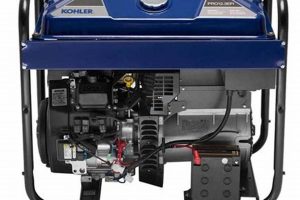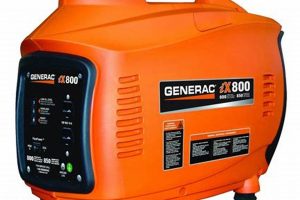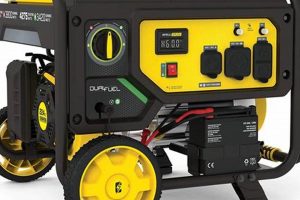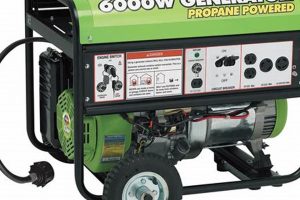The runtime of a portable generator fueled by propane depends on several intertwined factors. These include the generator’s size (measured in watts), the load placed upon it (the amount of power being drawn), the propane tank’s capacity, and the generator’s efficiency. For instance, a smaller generator powering a few essential appliances will typically run longer on a given tank than a larger generator powering an entire house.
Understanding the factors affecting runtime is crucial for emergency preparedness, recreational activities, and job site power solutions. Historically, generators have provided crucial backup power during natural disasters and outages, and accurately estimating runtime allows for effective planning and resource management. This knowledge empowers users to select appropriately sized equipment and fuel supplies for their specific needs, minimizing disruption and maximizing efficiency.
This article will delve deeper into each of these factors, providing practical guidance on calculating estimated runtimes and offering tips for maximizing efficiency and extending the usability of propane-powered generators. It will also explore different propane tank sizes and their corresponding runtimes, along with considerations for safe and efficient propane handling and storage.
Tips for Maximizing Propane Generator Runtime
Optimizing the runtime of a propane-powered generator involves careful consideration of several key factors. The following tips offer practical guidance on extending generator usability and ensuring adequate power availability.
Tip 1: Calculate Load Requirements. Accurately assess the wattage required to power the intended devices. Consult appliance manuals for wattage information and avoid exceeding the generator’s rated capacity. Overloading can lead to reduced runtime and potential damage.
Tip 2: Choose the Right Generator Size. Select a generator with sufficient wattage to handle the calculated load comfortably. Avoid significantly oversized generators, as they can consume more fuel even under light loads.
Tip 3: Utilize Eco-Mode (if available). Many modern generators feature an “eco-mode” or similar function that automatically adjusts engine speed based on the load. This can significantly improve fuel efficiency and extend runtime.
Tip 4: Maintain the Generator. Regular maintenance, including oil changes, air filter cleaning, and spark plug replacements, is essential for optimal performance and fuel efficiency.
Tip 5: Use Appropriately Sized Propane Tanks. Larger tanks provide longer runtimes but require more storage space. Consider the balance between runtime needs and available storage when selecting tank size.
Tip 6: Monitor Propane Levels. Regularly check the propane level in the tank to avoid unexpected shutdowns. Consider using a propane tank gauge for accurate monitoring.
Tip 7: Store Propane Safely. Propane tanks should be stored in a well-ventilated area away from heat sources and flammable materials. Follow all safety guidelines for proper storage and handling.
By implementing these strategies, users can significantly extend the runtime of their propane generators, ensuring reliable power availability when needed most. This translates to enhanced preparedness for emergencies, uninterrupted operation on job sites, and greater enjoyment of recreational activities.
This information provides a comprehensive overview of optimizing propane generator runtime. The following conclusion summarizes the key takeaways and emphasizes the importance of proper planning and operation.
1. Generator Size (Watts)
Generator size, measured in watts, is a critical determinant of runtime when using propane. It represents the generator’s power output capacity and directly influences how quickly propane is consumed. Understanding the relationship between generator size and runtime is essential for selecting appropriate equipment and ensuring sufficient power availability.
- Running Watts vs. Starting Watts
Generators have two wattage ratings: running watts (continuous power output) and starting watts (peak power for starting motorized appliances). Starting watts are typically higher than running watts. While running watts determine the sustained load capacity, starting watts are crucial for appliances with high initial power demands, like refrigerators or air conditioners. Selecting a generator with insufficient starting watts can lead to appliance startup failures or generator overload. This distinction is crucial for accurately estimating propane consumption and ensuring reliable operation.
- Matching Generator Size to Load Requirements
Accurately assessing the wattage demands of intended appliances is crucial for selecting an appropriately sized generator. Undersized generators can become overloaded, leading to reduced runtime, potential damage, and safety hazards. Oversized generators, while capable of handling the load, may operate inefficiently and consume more propane than necessary. Calculating the total running watts required by all intended devices enables users to choose a generator size that provides adequate power without excessive fuel consumption.
- Impact of Load on Runtime
The actual load placed on the generator significantly affects runtime. A generator operating near its maximum capacity will consume propane more quickly than one operating under a lighter load. For instance, a 5,000-watt generator powering a 1,000-watt load will run considerably longer on a given amount of propane than if it were powering a 4,000-watt load. Understanding this relationship is vital for maximizing runtime and ensuring adequate power availability.
- Efficiency Considerations
While generator size is a primary factor in runtime, generator efficiency also plays a role. More efficient generators convert a higher percentage of propane into usable power, leading to longer runtimes. This factor is particularly important for extended use applications and can significantly influence overall propane consumption. Comparing generator efficiency ratings alongside wattage output can assist in making informed purchasing decisions.
Selecting the appropriate generator size involves a careful balance between power requirements and propane consumption. By understanding the relationship between generator size, load, and efficiency, users can optimize runtime and ensure reliable power for their specific needs. This knowledge translates to better preparedness, more efficient operation, and ultimately, more effective power management.
2. Load (watts)
The load, measured in watts, represents the amount of power drawn from the generator at any given time. This factor significantly influences how long a portable generator can operate on a given amount of propane. Understanding the impact of load is crucial for managing power consumption and maximizing runtime.
- Calculating Total Load
Accurately determining the total load requires summing the wattage requirements of all devices connected to the generator. Consult appliance manuals for wattage specifications. This calculation should encompass both the running watts (continuous power consumption) and the starting watts (peak power required for startup) of each appliance. Overestimating the load provides a safety margin, while underestimating can lead to overload and reduced generator runtime.
- Load Management Strategies
Employing load management techniques can significantly extend generator runtime. Prioritize essential appliances and avoid running non-essential devices simultaneously. Staggering appliance usage, especially those with high starting watts, can prevent overloading the generator and conserve propane. Utilizing energy-efficient appliances further minimizes the load and maximizes runtime.
- Impact of Load Fluctuations
Load fluctuations, caused by devices cycling on and off, impact propane consumption. Generators consume more fuel under heavier loads. Therefore, minimizing load fluctuations contributes to more stable and efficient generator operation. Monitoring the load throughout operation allows for proactive adjustments and optimized propane usage.
- Relationship Between Load and Runtime
The relationship between load and runtime is inversely proportional. Higher loads result in shorter runtimes, while lower loads extend operational duration. A generator operating at 50% of its rated capacity will generally run significantly longer on a given propane supply compared to operating at 90% capacity. Understanding this relationship facilitates informed decisions regarding load management and power allocation.
Managing the load effectively is paramount for optimizing the runtime of a portable generator using propane. Accurately assessing power requirements, implementing load management strategies, and understanding the dynamic relationship between load and runtime contribute to more efficient propane usage and extended power availability.
3. Tank Size (gallons/pounds)
Propane tank size is directly correlated to generator runtime. Larger tanks hold more fuel, allowing for extended operation. However, choosing the right tank size involves balancing runtime requirements with practical considerations like portability, storage space, and cost.
- Standard Propane Tank Sizes
Common propane tank sizes for portable generators include 20-pound (4.7-gallon), 30-pound (7.1-gallon), 40-pound (9.4-gallon), and 100-pound (23.6-gallon) tanks. Larger tanks, such as 100-pound tanks, provide significantly longer runtimes but are less portable and require more storage space. Smaller tanks, like 20-pound tanks, offer greater portability but necessitate more frequent refills or exchanges during extended operation. Selecting the appropriate size depends on the specific application and anticipated runtime needs.
- Calculating Runtime Based on Tank Size
Estimating runtime based on tank size requires considering the generator’s fuel consumption rate, typically provided in the generator’s manual. This rate is often expressed in gallons per hour (GPH) or pounds per hour (PPH). By dividing the tank capacity by the fuel consumption rate, one can approximate the potential runtime. For example, a generator consuming 1 GPH connected to a 20-pound (4.7-gallon) tank would theoretically run for approximately 4.7 hours. This calculation provides a baseline estimate, with actual runtime varying depending on load and other factors.
- Connecting Multiple Propane Tanks
In scenarios requiring extended runtimes, connecting multiple propane tanks to the generator through a properly configured manifold system can provide a continuous fuel supply. This setup eliminates the need for frequent tank replacements and ensures uninterrupted operation. However, safety precautions, including proper ventilation and secure connections, are crucial when using multiple tanks.
- Portability and Storage Considerations
Tank size influences portability and storage requirements. Larger tanks, while offering longer runtimes, are heavier and bulkier, potentially limiting portability. Sufficient storage space is essential for safe and proper propane tank storage, especially for larger tanks. These practical considerations play a significant role in selecting an appropriate tank size for specific applications.
Propane tank size is an integral factor in determining generator runtime. Choosing the right tank size involves carefully balancing runtime needs with practical considerations like portability, storage capacity, and safety. Accurate runtime estimations, facilitated by understanding fuel consumption rates and employing appropriate tank configurations, enable effective planning and uninterrupted power availability.
4. Generator Efficiency
Generator efficiency plays a crucial role in determining the runtime of a propane-powered portable generator. A more efficient generator converts a higher percentage of the propane’s energy into usable electricity, directly impacting how long the generator can operate on a given amount of fuel. Understanding the factors influencing generator efficiency is essential for maximizing runtime and optimizing propane usage.
- Engine Design and Technology
The engine’s design and technology significantly impact efficiency. Advanced engine technologies, such as overhead valve (OHV) or inverter technology, generally offer higher efficiency compared to older or simpler engine designs. OHV engines optimize combustion, while inverter generators adjust engine speed based on load, further enhancing fuel efficiency and extending runtime. These design differences translate to varying propane consumption rates and overall operational durations.
- Maintenance and Operating Conditions
Regular maintenance, including oil changes, air filter cleaning, and spark plug replacement, is crucial for maintaining optimal generator efficiency. A well-maintained generator operates more efficiently, consuming less propane for the same power output. Operating conditions, such as altitude and temperature, can also influence efficiency. Generators typically perform less efficiently at higher altitudes or extreme temperatures, potentially affecting runtime.
- Load Level and Efficiency Curve
Generators operate most efficiently at a specific load level, typically around 50-75% of their rated capacity. Operating a generator significantly below or above its optimal load range can reduce efficiency and impact runtime. Consulting the generator’s efficiency curve, often provided in the manual, helps identify the most efficient operating range and optimize propane usage. Matching the load to the generator’s optimal efficiency zone maximizes runtime on a given propane supply.
- Fuel Quality and Type
While propane is generally a consistent fuel source, variations in quality can subtly impact generator efficiency. Using high-quality propane ensures optimal combustion and contributes to efficient operation. Additionally, some generators are designed for specific propane blends or purity levels. Using the recommended fuel type ensures compatibility and maximizes generator performance and runtime.
Generator efficiency is intrinsically linked to the runtime of a propane-powered portable generator. Factors such as engine design, maintenance, load management, and fuel quality all contribute to overall efficiency. By understanding and optimizing these factors, users can maximize the runtime achievable from a given propane supply, ensuring longer-lasting power availability for various applications. This translates to enhanced preparedness for emergencies, uninterrupted operation on job sites, and greater enjoyment of recreational activities.
5. Fuel Consumption Rate
Fuel consumption rate is a critical factor in determining the runtime of a propane-powered portable generator. This rate, typically expressed in gallons per hour (GPH) or pounds per hour (PPH), quantifies how much propane the generator uses over a specific period. Understanding this rate is essential for accurately estimating runtime and managing propane supply.
- Determining Fuel Consumption Rate
Manufacturers usually provide the fuel consumption rate in the generator’s specifications or owner’s manual. This rate can vary based on the generator’s size, load, and efficiency. Some manuals provide consumption rates at different load levels, allowing for more precise runtime estimations based on anticipated power usage. Knowing the specific fuel consumption rate is fundamental to calculating potential runtime.
- Calculating Runtime Based on Consumption Rate
Given the fuel consumption rate and the propane tank size, runtime can be estimated. Dividing the total propane available (in gallons or pounds) by the consumption rate (in GPH or PPH) yields an approximate runtime. For example, a generator with a consumption rate of 0.75 GPH connected to a 20-pound (4.7-gallon) tank would theoretically run for approximately 6.3 hours (4.7 gallons / 0.75 GPH). This calculation provides a valuable estimate, though actual runtime may vary slightly due to factors like load fluctuations and ambient conditions.
- Impact of Load on Consumption Rate
The load placed on the generator directly affects the fuel consumption rate. Higher loads demand more power, leading to increased propane consumption. Conversely, lower loads result in decreased consumption and extended runtime. Understanding this relationship is essential for managing power usage and optimizing runtime. Generators often operate most efficiently at a specific load range, typically around 50-75% of their rated capacity. Operating outside this range can increase fuel consumption and decrease overall efficiency.
- Using Fuel Consumption for Planning
Knowing the fuel consumption rate enables informed planning for various applications. Whether preparing for an emergency, powering a job site, or using a generator for recreational purposes, accurate runtime estimations facilitate effective propane supply management. This information allows users to determine the required propane tank size or the frequency of refills needed for uninterrupted operation, minimizing disruptions and maximizing preparedness.
Fuel consumption rate is intrinsically linked to the operational duration of a propane-powered portable generator. Accurate calculation of runtime, based on the consumption rate and propane tank size, is crucial for efficient power management. Understanding how load impacts consumption empowers informed decisions about power usage, ultimately maximizing the utility and effectiveness of portable generators.
Frequently Asked Questions
This section addresses common inquiries regarding the runtime of portable generators operating on propane. Clear and concise answers provide practical information for effective generator operation and power management.
Question 1: How long will a 3500-watt generator run on a 20-pound propane tank?
Runtime depends on the generator’s efficiency and the load. At 50% load, a reasonably efficient 3500-watt generator might run for 7-9 hours on a 20-pound propane tank. Refer to the generator’s manual for more precise estimates.
Question 2: Can the runtime be extended by using a larger propane tank?
Yes, larger propane tanks directly translate to longer runtimes. A 30-pound tank will provide approximately 50% more runtime than a 20-pound tank, assuming the load and generator remain constant.
Question 3: Does running a generator at full load affect its runtime?
Operating a generator at full load significantly reduces runtime compared to lower loads. Higher power demands result in increased propane consumption. It is generally recommended to operate generators below their maximum rated capacity for optimal efficiency and extended runtime.
Question 4: How is generator runtime affected by altitude?
Higher altitudes can decrease generator efficiency and, consequently, runtime. Thinner air at higher altitudes reduces the amount of oxygen available for combustion, impacting engine performance and fuel consumption.
Question 5: Can propane tanks be refilled while the generator is running?
Refilling a propane tank while the generator is running is generally discouraged. This practice presents potential safety hazards. It is recommended to shut down the generator and allow it to cool before attempting to refill or exchange propane tanks.
Question 6: How does generator maintenance affect runtime?
Regular maintenance, such as oil changes and air filter cleaning, is crucial for maximizing generator efficiency and runtime. A well-maintained generator operates more efficiently, consuming less fuel for the same power output.
Understanding the factors affecting generator runtime allows for informed decisions regarding propane usage, tank size selection, and load management. This knowledge translates to more efficient operation and reliable power availability.
This FAQ section provides a comprehensive overview of common questions related to generator runtime. For more specific inquiries or technical support, consult the generator’s owner’s manual or contact the manufacturer.
Conclusion
The duration a portable generator operates on propane hinges on a complex interplay of factors. Generator size, the power demands of connected devices, the capacity of the propane tank, and the generator’s efficiency all contribute significantly to the overall runtime. Accurately estimating runtime requires careful consideration of these elements and informed decision-making regarding load management and equipment selection. Proper maintenance and adherence to safety guidelines further optimize performance and ensure safe operation. Comprehending these interconnected factors empowers users to effectively plan for power needs, whether for emergencies, job sites, or recreational activities.
Effective power management through informed estimations of generator runtime contributes significantly to preparedness and resource optimization. Further research into advancements in generator technology and alternative fuel sources will continue to refine estimations and enhance the efficiency of portable power solutions. This ongoing exploration promises more sustainable and reliable power solutions for the future.






